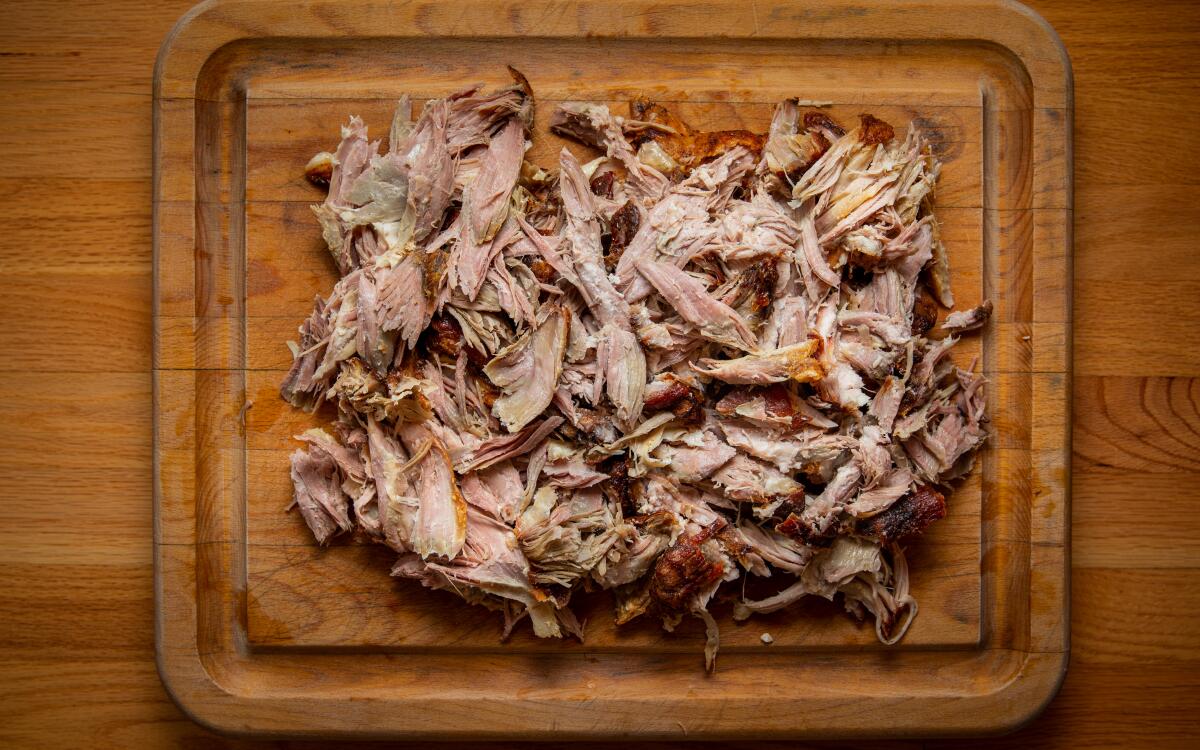Foolproof Pulled Pork

- Share via
Daniel Castillo, chef and owner of Heritage Barbecue in San Juan Capistrano, shares his method for cooking fall-off-the-bone pork shoulder in a home oven, which is easily adapted to an outdoor smoker or grill (see Variations). Most “butt” pork shoulders come with the skin already removed and the fat trimmed. If you can, ask your butcher to remove the skin but leave all the fat intact so that it can render around the meat while it roasts, keeping it tender and adding more flavor.
This pork takes at least 14 hours to cook, so plan accordingly. I’ve found the best approach is to put the pork in the oven right before you go to bed, so it is finished cooking around lunchtime the next day; otherwise, you will have to wake up before sunrise the day of to get it started so it’s ready by dinnertime. Either way, check on the pork every hour after 7 or 8 hours because, if your oven is like mine, it might shut itself off after so many hours at such a low temperature. Trust me, you don’t want to find this out the hard way.
Remove the pork from the refrigerator 1 hour before you plan to cook it so it has time to come to room temperature; this allows for more even cooking. Place the pork fat side up on a rack set inside a large roasting pan (or use a wire rack set in a rimmed baking sheet). Arrange your oven racks in the lower third of your oven and heat the oven to 400 degrees.
Season the pork liberally with salt and pepper and/or your seasonings of choice. Arrange the pork fat side up in the oven and roast for 30 minutes. Using heat-proof gloves or paper towels covering your hands, flip the pork over so it’s fat side down; continue roasting until well-browned on the outside, about 30 minutes more.
Flip the pork once more so it is fat side up again, then reduce the oven temperature to 250 degrees. Continue slow-roasting the pork until an instant-read thermometer inserted into the center of the pork reads at least 200 degrees, 10 to 12 hours.
Remove the pork from the oven and transfer it to a large sheet of double-thick foil. Cover the pork tightly in the foil and let rest at room temperature for at least 1 hour and then until you can touch the meat with your bare hands without burning yourself (140 degrees). Uncover the meat and shred or chop to serve.
Set up your backyard smoker or charcoal grill for indirect grilling at 250 degrees. Follow the steps above, placing the pork on the rack in the roasting pan on the grill grate, and cook until the internal temperature of the pork reaches 200 degrees, adjusting the smoker heat to maintain a temperature between 200 and 250 degrees the entire time. Wrap the pork in foil as in Step 4.
Seasonings
Go beyond salt and pepper and season the pork with sazón, your favorite barbecue rub, or dry-spice mix until it’s well-coated all over, about 3 to 4 tablespoons. Know that sugar will burn so try to avoid using too much. If you have the time, rub the pork with the spices of your choice and let sit uncovered in the refrigerator for up to 1 day to help develop a flavorful crust on the outside once cooked.
Get our Cooking newsletter.
Your roundup of inspiring recipes and kitchen tricks.
You may occasionally receive promotional content from the Los Angeles Times.
















